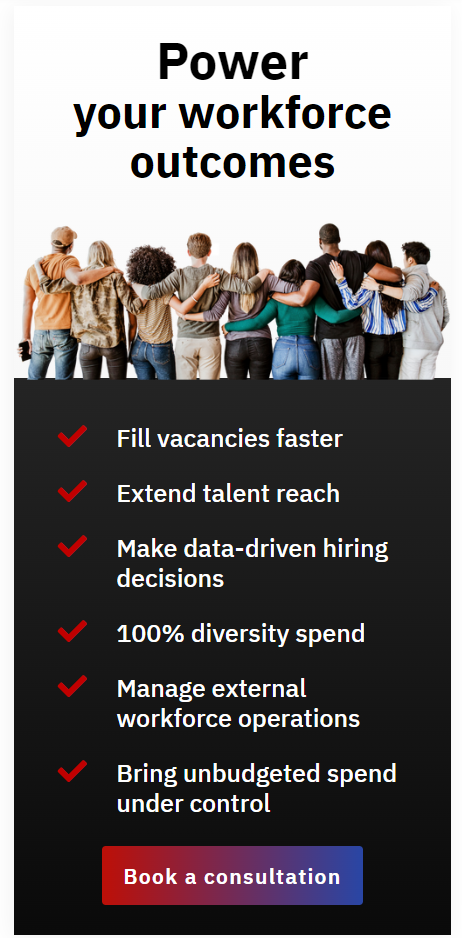
Erica Tomlin - 6 min read
How to manage a diverse workforce
Diversity is an all-encompassing term that describes people’s unique characteristics within a group or organization. These can include gender, race, ethnicity, religion, age, sexual orientation, physical abilities, etc.
The benefits of having a diverse workforce are made clear by McKinsey, who reveal that organizations with a diverse workforce are 35% more likely to outperform their competitors.
However, diversity and inclusion in the workplace is an issue that is still largely unresolved. For example, a study demonstrated that 78% of employees believe that their organizations lack diverse leadership. Additionally, Black Americans (23%) and Latinos (24%) were more likely to have been laid off during the pandemic than their White (15%) and Asian American (13%) counterparts. These statistics highlight the desperate need for a change in the way organizations deal with D&I in their workforce management strategies. In addition, organizations need to ensure that everything is being done within their company to combat this issue.
Diversity is not just good for business, but it’s also the right thing to do.
The challenges of workplace diversity
Having said that, it’s clear that having D&I goals and achieving them are two very different things. There are challenges for organizations when looking in detail at their Diverse Workforce Strategy (how they hire and manage diverse workers), and these include:
- Knowing where to start – there’s a lot to consider, and it can be a daunting process to start at the very beginning.
- Understanding D&I within the organization itself – without having a complete picture of where diversity fits into the company, it can be challenging to curate best-fit strategies for that specific business.
- Getting a commitment to D&I – change can be difficult to accomplish in any business, and not everyone may be bothered or committed to the alterations made.
- Using diversity training effectively – try as we might, diversity training means little if it’s not used effectively. Still, it may be challenging to implement that training without the commitment of others.
To make diversity work, it is vital to consider the organizational context of D&I before evaluating which strategies would work well for your business. What works for one company may not work for another. If a full assessment isn’t completed thoroughly using data and insights, this inaccuracy may result in practices that are disjointed or even ineffective.
Key Diverse Workforce Management Strategies
1. Company Policy
Company policies around diversity and culture are crucial in taking the first steps towards implementing organizational diversity and inclusion. Employee handbooks, diversity policies, flexible working policies, reasonable adjustments, etc., are just a few examples of the kinds of documentation your organization can easily implement.
These policies and guides help set the tone for the business but are also valuable to managers, allowing them to support their workers and employees. To show further support, zero-tolerance policies can also be a helpful tool, as is the practice of following through with company procedure. This will emphasize the importance of these initiatives and highlights your organization’s commitment to diversity and inclusion.
2. Company Culture
There are some straightforward ways that you can alter the company culture to embrace diversity in the workplace, including:
- Promoting transparency and communication
- Encouraging diverse working teams
- Celebrating Individuality
There are more ways to achieve this, but even the smallest of changes in the culture of a workplace can improve an employee’s experience and their feeling of value. However, every business is different, so a tailored approach to how your organization embraces diversity in its culture is required.
3. Recruitment
Make diversity a part of your recruiting and hiring processes by critically assessing how you appraise and hire candidates. The EW Group has identified seven key steps in diversifying these processes.
- Write inclusive job descriptions – clearly highlighting the essential skills and competencies required while avoiding organization-specific language.
- Broaden talent pool searches – thinking about where you are placing the ad and considering more creative ways of advertising your vacancies.
- Design an inclusive application process – design your processes in a way that won’t confuse or deter your applicants.
- Make shortlisting fair – this could be achieved using unbiased approaches or including two people in the shortlisting process to avoid bias.
- Allow for reasonable adjustments – check with your applicants whether they require any reasonable adjustments and accommodate them.
- Prepare for an inclusive interview – Prepare for your interviews, down to the questions you’ll be asking and how you will score each applicant’s answers.
- Inclusive Interview – During the interview itself, set the right tone with a diverse panel of interviewers, making sure to listen actively to the individual.
4. Training
Your team members must be trained in your Diversity & Inclusion policies and the company culture to ensure that all members feel valued and welcomed. CIPD highlights two key training interventions as potential avenues for worker diversity training. These are unconscious bias training, where people are taught about prejudice, and perspective-taking, which encourages people to put themselves in the shoes of individuals who might face bias in their day-to-day lives. These kinds of training programs allow individuals to develop their awareness and knowledge of diversity issues, and how to use this knowledge in everyday work.
5. Commitment to D&I
Managing a diverse workforce can be difficult, particularly if there is a lack of commitment from leaders and workers. Therefore, it’s essential to ensure that your leadership team is aligned with your D&I goals and trained to manage their diverse teams. If not, it will continue to be challenging to set the tone of what is expected from all workers.
6. Day-to-day Management
It’s important not to rely on just the policies and training to make the difference. How you manage your diverse workforce on a day-to-day basis is just as important. There are several things you can do to adapt your management style to be more inclusive, such as:
- Invest your time to learn more about your workers to understand how they work and how you might work well together.
- Communicate regularly with openness and transparency, perhaps involving your team in as much as possible.
- Following through with company procedure and not permitting inappropriate behaviour to go ignored and unpenalized.
- Assess your own bias (for example, you may work more with some individuals rather than others) and work to be fairer and more inclusive in your decision-making.
- Encourage diverse teams, perhaps even mixing up team arrangements to make sure that there are opportunities for everyone in your team to grow and feel valued.
7. Diversity is more than a buzzword
Lastly, do not treat diversity as if it’s a buzzword or a box to tick for your organization. It’s a continuing goal that can’t be fixed in just one day and later forgotten. It takes a considerable amount of change on an organizational and individual level to ensure that diversity and inclusion initiatives are met on a long-term basis. Therefore, it’s also essential to continue reassessing your organizational structure and culture against D&I to ascertain whether your company can do more.
You may also like:
Optimizing Contingent Workforce Management with MSP Expertise
Optimizing Contingent Workforce Management with MSP ExpertiseNowadays companies are increasingly relying on a contingent workforce to maintain flexibility and adapt to changing demands. A contingent workforce, comprising freelancers, consultants, and independent...
Streamlining Contingent Worker Onboarding: Accelerating Time-to-Productivity
Streamlining Contingent Worker Onboarding: Accelerating Time-to-ProductivityOrganizations are turning to contingent workers to bridge talent gaps and adapt to fluctuating demands. However, the traditional onboarding processes, often designed for permanent hires, are...
Why Statement of Work has become the most critical element of IT resourcing
Statement of Work contracts are today widely used in various industries. Find out how SOW can be used to fill talent gaps in IT.





